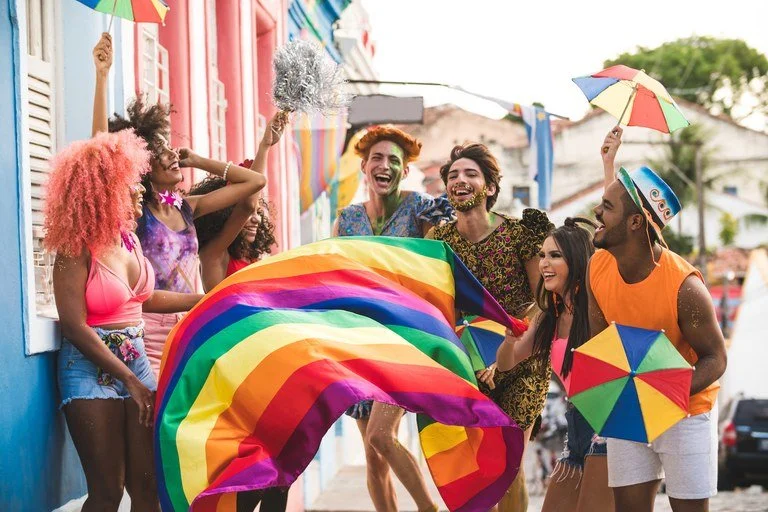6 WAYS TO BE MORE INCLUSIVE OF BISEXUAL PEOPLE DURING PRIDE MONTH
Most Pride attendees don’t go out of their way to heckle bisexual people, but many bi folks don’t feel particularly welcome at Pride. They feel they can’t express being openly bisexual without receiving a barrage of intrusive questions or disparaging remarks. For example, some people assume bisexuality is just a phase, or ask about your sexual history, and that's just...not cool.
In recent years, the LGBTQIA+ community has been pushing for more inclusivity among all its members — adding more letters to the acronym — in the hopes of encompassing all individuals who don’t feel represented by the original four letters. Yet at Pride events across the world, the acronym still seems synonymous with “gay,” and unless something is specifically stated to be bisexual [or transgender], meaning it explicitly notes that it’s an event, float, booth, etc. for bisexual people, it is assumed to be gay [and cisgender].
Allure reached out to activists in the bisexual community to learn of ways Pride organizers and attendees can be more inclusive of bisexual folks at Pride events. Read on to learn more.
1. DON’T CALL IT “GAY PRIDE”
Words matter. Whoever came up with the phrase “sticks and stones may break my bones but words will never hurt me” was a little off the mark. An impactful thing everyone can do is to stop calling Pride “Gay Pride” and instead simply call the festivities “Pride.” Or, if you want to have some form of an LGBTQIA+ indicator in front of Pride to make it clear you’re not talking about one of the seven deadly sins, but the month of June, call it “Queer Pride.”
It’s such an easy switch to make, but one that can really make Pride feel more inclusive of various sexual and gender identities.
2. KNOW YOUR QUEER HISTORY
Unlike what the 2015 movie Stonewall would have you believe, the original Stonewall riots were started by bisexual, trans, and nonbinary people of color. It’s necessary to know your queer herstory to remember that bi folks have always been at the forefront of queer liberation, fighting for the rights of all members of the larger LGBTQIA+ community.
As actor, singer, and activist Sara Ramirez tells Allure:
“I could give you a list of behaviors that help the bi+ community feel welcome, seen, and named, but the truth is that right now we need healing and solidarity. I don’t think we can afford to be shady toward one another. We never really could. Acceptance that Pride is about everyone in the LGBTQIA+ community is a great place to start. If you can’t accept that, then stay home. If you can accept this fact and respect it, then, by all means, join the fun everyone, including the bi+ community, WILL be having. And don’t forget: bi+ community is made up of cis, trans, and nonbinary folks. Don’t get it twisted. bi+ icon Brenda Howard invented Pride. Trans bi+ icon Sylvia Rivera fought for our most vulnerable’s rights on the street. Andrea Jenkins made history last year by becoming the first black openly transgender and bi+ woman elected to public office. We’ve been here all along and we’re not going anywhere. We’re here to stay. Get used to it. Know your queer history!”
3. CREATE MORE BI-SPECIFIC SPACES AT PRIDE
Rio Veradonir, the assistant director of the American Institute of Bisexuality, says it would be helpful if “Pride organizers could give the bi community free spaces for visibility. L.A. Pride has done this for the trans community several times.”
This may not be surprising, but bisexual organizations aren’t typically flush with cash. In fact, according to the 40th annual LGBT Funders Report, which has tracked funding to LGBT organizations between 1970 and 2010, lesbian and gay organizations received $487 million in funding; transgender organizations received $16 million; and bisexual organizations received a mere $84,000 in those same four decades. Both transgender and bisexual organizations deserve more funding than they're receiving.
Additionally, Veradonir notes, “Large free spaces were made available for trans orgs to set up ways to outreach and interact with the attendees. Meanwhile, our org, amBi, has had to spend a fortune for booths.” Simply put, more booths would translate to more visibility and inclusion.
4. MAKE LGBTQIA+ SPACES INCLUSIVE OF EVERYONE IN THE ACRONYM
The need for bi-specific spaces emerges from a fact that Veradonir makes clear: “Unless a parade entry or booth is explicitly branded as being bisexual, attendees tend to assume every other entry or booth is gay.” That’s why he believes organizers of Pride events should make it clear in the advertising and branding that bi people are involved in every step of the process, including at most booths and on many floats, at parades, and events.
"If you are bi, just being visible is a productive means of addressing biphobia and dispelling myths and stereotypes."
"If they did that, Pride would feel less hostile [toward bi folks],” Veradonir concludes. “Pride leadership needs to step up and make bi folks feel more welcome at a systemic level.” This goes for all folks who are LGBTQIA+ — you're welcome at Pride, and you should feel that way.
5. GET TO KNOW OTHER ATTENDEES
Getting to know other members of your community can be a huge step when it comes to feeling more welcome. “Beyond not making assumptions about a person’s sexuality or identity, I think a great thing for [attendees] to do is to get to know the people,” says Talia Squires, editor in chief of bisexual.org. “I know Pride is a big party, and that's super awesome, but also, bother to go meet new people and hear their stories."
Often, members of the larger queer community self-segregate socially. Gay men hang out with other gay men, bi folks stick together, and so too do lesbian and trans communities. “[Pride] is a great opportunity because you get to break out of your normal circle of people and get exposed to different [LGBTQIA+] groups,” Squires says.
6. IF YOU’RE BI OR PAN, BE VISIBLE
In addition to all the things Pride organizations and other attendees can to do make Pride more inclusive of bi folks, there’s also something we can do. “Be visible!” says Lorien Hunter, editor in chief of the upcoming digital publication Queer Majority. “If you are bi, just being visible is a productive means of addressing biphobia and dispelling myths and stereotypes. The truth is that we are already everywhere, but in many cases, people just aren’t aware of our presence. If you are in a position to be out and visible, please do it. Often this decision will empower others to do the same.”
Oh, and last but definitely not least, “Don’t boo us,” Squires says. “That's a basic one.”


